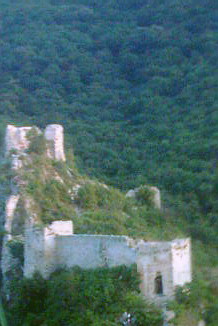Soko Grad (Sokobanja)
| Soko Grad; Sokolac Соко Град; Соколац | |
|---|---|
| near Sokobanja | |
 Remains of Sokolac | |
| Site information | |
| Type | Strategic fortification |
| Open to the public | Yes |
| Location | |
 | |
| Coordinates | 43°38′06″N 21°53′35″E / 43.63500°N 21.89306°E |
| Site history | |
| Built | 6th century |
| Built by | Justinian I |
| Materials | Stone |
Soko Grad (
History
The fortress was founded in the 6th century during the reign of

Characteristics
The original fortification built by Justinian was the citadel built on the tallest part of the rock, rendering it practically unreachable by the enemy. During the subsequent development in Serbian state, the fortress expanded around the citadel and spread lower down the rock. In the middle of the fortification on the top was a citadel with a dominant main tower. From there bulwarks were lowering toward Moravica, forming that way space of Lower town, that was built on more reachable ground. The entire fortification complex had several towers, of which only a few remain today. Only the first entrance tower in Upper town is preserved and in good shape, while other towers and bulwarks are in ruins.

See also
- Monuments of Culture of Great Importance
- Tourism in Serbia
References
- ^ Monuments of Culture in Serbia: "СОКО ГРАД" (SANU) (in Serbian and English)
External links
- (in Serbian)Soko Grad article in Politikin Zabavnik
- Section Fortress - Soko Grad
- Sokograd

